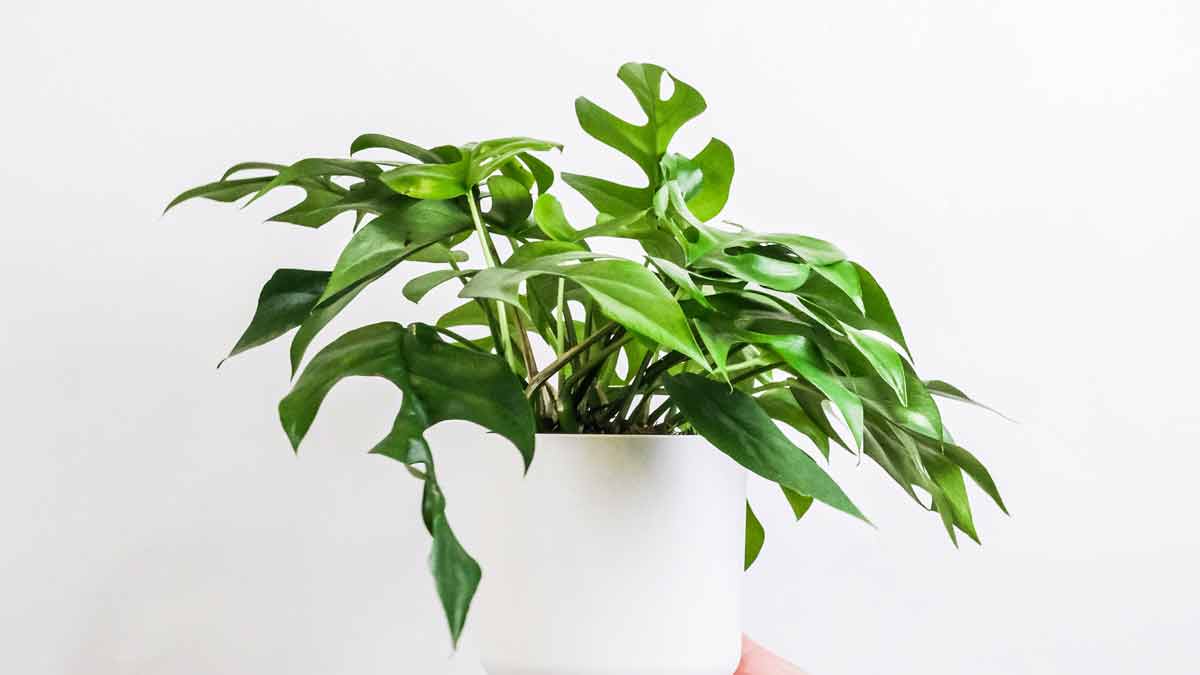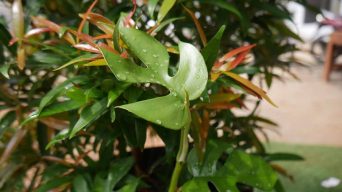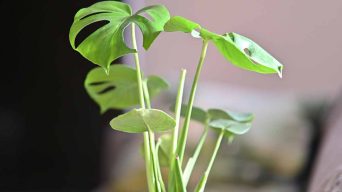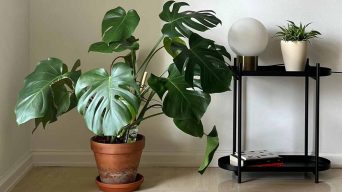Rhaphidophora tetrasperma, also known as Mini Monstera or Monstera Minima, may have growth issues due to low light, over/underwatering, soil conditions, or pests. To encourage growth, provide bright, indirect light, keep the soil moist but not waterlogged, and provide support for climbing. Propagation can fix broken stems.
Have you recently bought a Rhaphidophora tetrasperma, only to find that it’s not growing? If so, you’re probably wondering what the problem is.
Don’t worry—it could be any number of things! In this article, we’ll discuss some of the people’s most common issues with Rhaphidophora tetrasperma and how to fix them.
We’ll cover everything from water needs to light requirements for these beautiful plants.
So if your plant isn’t thriving as you’d hoped, read on for helpful tips and tricks that will help get it back on track!
Common Issues Affecting Rhaphidophora Tetrasperma Growth
Rhaphidophora tetrasperma, also known as the Mini Monstera or Monstera Minima, is a popular houseplant that can be difficult to care for.
While it’s easy to get caught up in the beauty of this plant, some common issues can prevent it from growing and thriving.
Let’s look at some of the most common problems that may be preventing your Mini Monstera from growing.
Low Light Conditions
Rhaphidophora tetrasperma needs bright, indirect light to grow and thrive.
If your plant isn’t getting enough light, it will stretch out and become leggy.
To prevent this from happening, place your plant in an area with plenty of bright, indirect sunlight.
East- or west-facing windows are ideal.
Avoid placing it in direct sunlight, as this can cause sunburn on the Monstera leaves.
If you’re having trouble finding a suitable spot in your home, consider investing in grow lights to give your plant the light it needs.
Overwatering or Underwatering
One of the most common causes of stunted growth in Rhaphidophora tetrasperma is overwatering or underwatering.
Too much water can lead to root rot, eventually killing your plant if not treated quickly.
On the other hand, too little water will cause the Monstera leaves to turn brown and crispy, and the plant will start to wilt.
The best way to avoid these problems is by checking the soil before watering and only adding water when the top inch of the soil feels dry to the touch.
Generally, a Monstera must be watered once every 7-10 days.
Soil Conditions
The Rhaphidophora tetrasperma plant prefers well-draining potting soil that is slightly acidic (pH 6-7).
If you’re using regular potting soil, you may need to add some perlite or pumice for better drainage.
Too dense or waterlogged soil can also lead to root rot, so ensuring your soil has the right texture is important.
It’s also important to make sure your pot has adequate drainage holes so excess water can escape easily.
Temperature Issues
Rhaphidophora tetrasperma prefers temperatures between 65°F – 85°F (18°C – 29°C).
If temperatures drop below 60°F (15°C) for an extended period, it could cause damage to your plant’s leaves and roots, leading to stunted growth or death of your plant altogether.
It’s also important to avoid sudden temperature changes as this can shock your plant and cause stress, leading to poor health and a slow growth rate.
Keep the temperature in your home relatively constant to prevent your plant from becoming stressed and help promote healthy growth.
Humidity Issues
The Rhaphidophora tetrasperma plant needs humid conditions to grow and thrive. Monstera plants need humidity levels of at least 60 to 70%.
If the humidity in your home is too low, you may need to increase the humidity around your plant.
This can be done by misting the leaves or setting up a humidity tray near the pot.
If you don’t have access to a humidifier or mister, consider investing in one to help keep your Monstera healthy and happy.
Nutrient Deficiencies
Rhaphidophora tetrasperma needs a balanced diet of essential nutrients such as nitrogen, phosphorus, and potassium for it to grow properly.
If any of these nutrients is lacking, you may notice yellowing Monstera leaves or stunted growth due to a lack of energy produced by photosynthesis.
You can supplement these nutrients by using a liquid fertilizer every couple of weeks during the active growing season (spring through fall).
Ensure you’re using a fertilizer specifically designed for houseplants, and follow the instructions carefully to avoid burning your plant.
Overfertilizing
Rhaphidophora tetrasperma plants can suffer from too much fertilizer!
Too much fertilizer can burn the roots, making them unable to absorb water properly. Overfertilization will stunt its growth rate and possibly even kill it if left untreated for too long!
When fertilizing your Monstera, it’s important to stick to a light feeding schedule every couple of weeks.
Start with half the recommended dosage and increase gradually if needed.
It’s also important to flush the potting soil after fertilizing so that excess nutrients can be washed away. This will help prevent any buildup of fertilizer salts in the soil and keep your plant healthy.
Pot Size
The pot size you choose for your Rhaphidophora tetrasperma is very important.
If the Monstera pot is too small, then its roots won’t have enough room to spread out, leading them to be unable to absorb water properly, which will stunt its growth rate!
Make sure you choose a pot at least twice as wide as its current one so that its roots have plenty of room to grow without becoming cramped!
Pest Infestation
Pests such as aphids, mealybugs, and spider mites are all potential threats when caring for Mini Monstera plants indoors!
These pests feed on sap from new shoots, causing them to be unable to produce new foliage, resulting in stunted growth!
To prevent pests from infesting your plants, inspect them regularly for signs such as insect webs or sticky sap on their leaves!
If you find any pests, treat them immediately with natural pest control methods such as neem oil or insecticidal soap.
Tips for Encouraging Rhaphidophora Tetrasperma Growing
Rhaphidophora tetrasperma plants can be challenging to grow indoors, but with proper care and attention, you can ensure your Monstera grows healthy and strong!
To encourage growth, make sure you provide your plant with the right environment and care.
Here are some tips for encouraging growth in your Rhaphidophora tetrasperma.
1. Providing Bright Indirect Light
Rhaphidophora tetraspermas need bright, indirect light for optimal growth.
Place them near an east- or west-facing window, and make sure the leaves don’t touch the glass.
Monstera plants can sunburn easily, so avoid direct sunlight!
If direct sunlight is unavoidable, use sheer curtains or blinds to filter it out.
You can also use artificial grow lights if necessary.
2. Keeping the Soil Moist but Not Waterlogged
Rhaphidophora tetraspermas need consistently moist soil to grow well.
Water your plant when the top inch of soil feels dry to the touch and avoid overwatering—this can cause root rot and other problems.
Make sure the pot has drainage holes so excess water can escape, and consider using a moisture meter or self-watering pot to ensure your plant gets just enough H2O.
3. Using Well-Draining Soil
In addition to keeping the soil moist, using well-draining soil for your Rhaphidophora tetrasperma plant is important.
A good mix should contain equal parts peat moss, perlite, and composted bark chips or coconut coir chips.
This will help keep water from pooling around the roots and causing root rot or other issues.
4. Using a Humidifier
Rhaphidophoras like humid environments, so consider investing in a humidifier if you live in a dry climate or have central heating/air conditioning in your home.
This will help keep your plant healthy and encourage growth.
You can also mist your Monstera plants with lukewarm water every few days if needed—make sure not to overdo it!
5. Providing Support for the Plant’s Climbing Habit
Rhaphidophoras tend to climb up whatever they can find—so make sure there’s something nearby for them to grab onto!
A trellis, moss pole, or bamboo stake are all great options for providing support while allowing room for growth. This will help keep their stems strong and encourage new leaf growth along the way.
To stake a Monstera, simply insert the stake into the pot near the base of the plant and gently wrap some string or twine around it.
Then, tie it loosely onto the trellis or pole in a few places so your plant has something to climb up as it grows.
6. Propagation as a Solution for Broken Stems or Other Issues
If you find that one of your Rhaphidophora tetrasperma stems is broken (or if you’re having other issues with growth), propagation is often an effective solution!
To propagate the Monstera Minima, cut off a healthy stem and stick it in water or a potting mix.
With time, the stem will take root, and you’ll have a new plant!
This is also an easy way to increase your Monstera collection if you want more than one of these beautiful plants in your home.
Final Thoughts
Rhaphidophora tetrasperma, or “Mini Monstera”, is a beloved tropical plant that requires the right conditions to grow.
Without the ideal environment, however, it will not grow as expected.
To ensure your Mini Monstera grows properly, you must provide adequate sunlight, water, and humidity levels.
Keeping an eye on the soil moisture and fertilizing regularly will also help keep your plant healthy.
Although it can be discouraging to see your Rhaphidophora tetrasperma not growing, keeping your plant healthy with the right care and attention is possible.
Don’t give up on this lovable houseplant if you feel like you are struggling to make it thrive.
With a little patience and the help of these tips, you should be able to keep your Mini Monstera happy and growing!
Good luck, and happy gardening!







